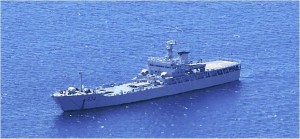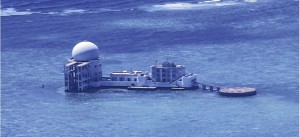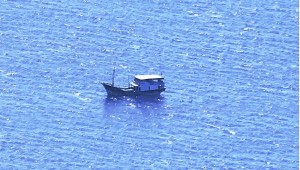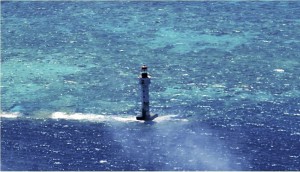Facing up to China with sheer guts

A PHOTO taken by the Philippine Navy Islander 314 during an aerial reconnaissance on July 17 shows China’s People’s Liberation Army Navy Landing Ship 934 anchored inside Zamora (Subi) Reef.
If a surface-to-air missile were fired from a Chinese frigate, it would have easily taken out a blue-colored surveillance plane of the Philippine Navy that flew over the Hasa-Hasa Reef in the morning of July 14.
The plane was flying dangerously close to a Chinese fleet spread out in battle formation as it sped toward a solitary warship—one of their own—which had run aground on the contested shoal the night before.
Among those aboard the aircraft included no less than the second-in-command of the regional brass, Brig. Gen. Elmer R. Amon, and several other senior officials of the Philippine military’s Western Command (Wescom).
The pilot of a responding fighter plane, who was just returning from honeymoon, had to fly on a straight line so as to conserve fuel and return to his nervous wife.
Had the missile been let loose—a scenario considered by Wescom officials when they decided to undertake a flyby over the Hasa-Hasa Reef, where the Chinese frigate was stuck—the pilot of the fighter plane would not know what hit him. His plane, the only other air asset at hand for such circumstances, has no evasive capabilities like flares and decoys to confuse a heat-seeking missile and make an escape.
One of the officers on board the surveillance plane told the Inquirer that they believed they were being tracked by the missile. Anything could happen, and a missile strike would have plunged the Philippines into an unwanted war with China, with far-reaching regional and global implications.
At least, it would have averted the recent Association of Southeast Asian Nation (Asean) meltdown in Cambodia over the issue of Scarborough, along with China’s renewed aggression.

CHINA’S radar dome in Subi Reef seen by the Philippine Navy Islander during an aerial reconnaissance on July 17.
Grainy images
As the bleak scenario did not play out, Wescom, which has jurisdiction over the Philippine claim in the West Philippine Sea, was instead rewarded with grainy pictures of Chinese war vessels maneuvering inside Philippine territory and disappearing, albeit temporarily into the blue.
It was also observed that based on previous information confirmed by recent pictures, the Chinese were speeding up development of the Subi Reef, an islet closest to the main Philippine-occupied island of Pag-asa.
A landing ship usually associated with construction and engineering works was spotted in Subi’s lagoon, evidence of the buildup activities. According to Kalayaan Mayor Eugenio Bito-onon Jr., the Chinese only recently took down the scaffolding of a four-story building in Subi, which houses a giant dome-shaped radar on top.
The buildup, the officials observed, was centered around the radar facility and the installation of a lighthouse and mooring buoys leading to the inner lagoon, which can cradle a large warship.
The next day, Beijing announced that it was sending a fleet of 30 fishing vessels back into the Spratlys, escorted by warships. They were last reported to be in Vietnam’s maritime backyard.
Wescom war room
The war room of Wescom under Lt. Gen. Juancho Sabban is just big enough to assemble the command’s top brass around an oversized oval table. There are no electronic contraptions more advanced than an overhead projector to suggest any sophisticated monitoring over the vast West Philippine Sea.
At the center of the table is a three-dimensional clay rendition of the entire Spratlys, with miniature flags of all countries laying claim to it. It is not scaled and looks crudely rendered, but it is useful enough to put everyone on the same page as to what particular claimant country is occupying which islet or shoal.
Not nearly enough of the hundreds of islets have Chinese markers, but it belies the erstwhile heavily felt presence and military buildup of China.
“The presumption was that the Chinese might fire the first shot. At least that’s what they have been trying to project they might do,” said Lt. Col. Neil Estrella, Wescom spokesperson.
Just as when China has been playing the game of brinkmanship in the disputed region to assert its claim, the Philippines is planning to catch up militarily with what it described was a goal to install “minimum credible defense.”
“At a given situation, for external and internal defense, it’s a condition where we can act. It’s a condition where you have armaments, you can communicate for command and control, and have human resources available,” Estrella said.
Among the capability upgrades on the pipeline for Wescom are land-based surveillance monitoring and sea interdiction capability as part of the Armed Forces of the Philippines’ overall modernization thrust, according to defense sources.
In the meantime, Wescom has to contend with a single surveillance light plane and a fighter plane that cannot afford to loiter too long in the sea expanse of the Kalayaan Island chain lest it runs out of fuel.
Intelligence support
Is the Philippines getting support from the United States in terms of live satellite feeds showing China’s movements? Wescom is mum. But a source disclosed that during the incident in Reed Bank back in February when a Chinese warship threatened to ram a government survey vessel, the United States was constantly feeding the Philippines with real-time satellite feed.
Intelligence information has allowed the Wescom brass to make decisions from the war room without having to wait for orders from higher authorities or Malacañang to take over operational command, the source said.
“General Sabban decided to deploy our air and naval assets to guard the exploration vessel. General Sabban decided he could not wait because all Forum Energy needed was a few more days to complete the survey,” Estrella acknowledged when sought to confirm the information gathered by the Inquirer.
As AFP assets approached the beleaguered survey vessel of the oil contract Forum Energy, the Chinese stood down and backed away.
State of preparedness
Estrella said the regional top brass had recently begun going through “contingency scenarios” in case a limited skirmish with China takes place. “We have those in place long time ago,” he said.
But what happens, for example, when just one missile misses its target and explodes in a populated area in the mainland? Do we wait for Congress to declare war?
Estrella said the AFP has “rules of engagement in place.”
The military command is not inclined to unduly alarm the civilian population with warnings of an imminent danger from errant Chinese missiles or deliberate armed provocation. Most

THIS Chinese fishing vessel was spotted by the Philippine Navy reconnaissance plane on July 17 in the lagoon of Subi Reef.
senior defense officials, however, feel that while the operational command is clear on the “rules of engagement,” the overarching defense strategy needs to be clearly understood.
“We know that even if we realize we are facing a much superior military force, we have no other option but to impose our sovereignty over our territory,” Estrella said.
But Kalayaan Mayor Bito-onon, a devout Adventist follower, laughs off scenarios of a Chinese invasion or aggression. “It’s just because of my religious conviction. It’s not in the scriptures that China will prevail here,” he mused.
In the capital city of Puerto Princesa, there is little evidence of worrying among the locals. None of the local government units have expressed concern and Gov. Abraham Kahlil Mitra has not responded to queries on whether the provincial government plans to weigh in on the territorial dispute with China.
“I think only when we find half the stores in town are closed, and that’s because they are Chinese, only then shall people realize were in some kind of armed conflict,” said businessman Rey Rafols.
PHOTOS COURTESY OF WESTERN COMMAND















